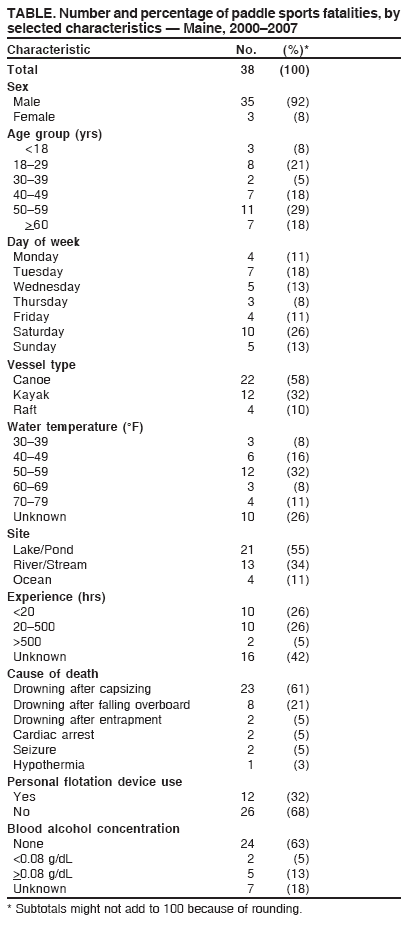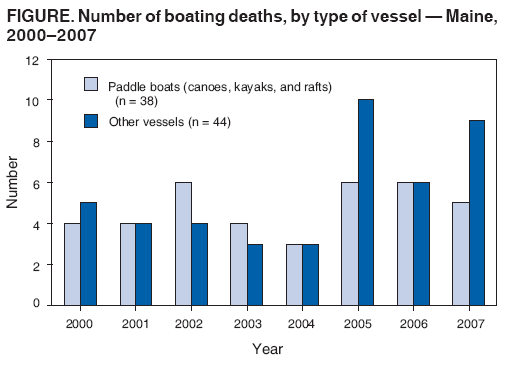 |
|
|
|
|
|
|
| ||||||||||
|
|
|
|
|
|
|
||||
| ||||||||||
|
|
|
|
|
Persons using assistive technology might not be able to fully access information in this file. For assistance, please send e-mail to: mmwrq@cdc.gov. Type 508 Accommodation and the title of the report in the subject line of e-mail. Paddle Sports Fatalities --- Maine, 2000--2007In 2006, approximately 70 million persons in the United States participated in recreational boating (1), and paddle sports vessels (i.e., canoes, kayaks, and inflatable rafts) made up the fastest-growing segment of the boating market. From 2005 to 2006, canoe sales in the United States increased by 23%, and kayak sales increased by 11%, while powerboat sales decreased by 5% (1). To analyze the trends and characteristics of deaths associated with paddle sports, the Maine Department of Health and Human Services examined data on fatalities that occurred during 2000--2007. The results of this analysis determined that paddle sports deaths were associated with inexperience, alcohol use, and not using a personal flotation device (PFD). To reduce the risk for paddle sports fatalities, boating organizations and water-sport enforcement agencies should encourage boater safety education, use of PFDs, and avoidance of alcohol before and during boating. A case was defined as a fatality occurring in Maine during 2000--2007 that was associated with use of a canoe, kayak, or raft in a natural water source (i.e., lake, pond, river, stream, or ocean). Cases were identified by reviewing death certificates with International Classification of Diseases, Tenth Revision codes V90 and V92 and reports from the Maine Department of Inland Fisheries and Wildlife, the Maine Office of Chief Medical Examiner, and the U.S. Coast Guard. Supplemental information, including additional witness statements, was obtained from newspaper accounts. Level of experience was defined as the total hours spent in a particular paddle sport vessel during the lifetime of the decedent and was ascertained through interviews by the investigating warden with friends and family members of the decedent. The following case reports illustrate common scenarios and risk factors. Case 1. In May 2004, three persons aged 19 years paddled in a canoe to an island on a lake. On the return trip, the wind picked up, and a wave swamped their canoe. None of the three persons was wearing a PFD. Two persons swam back to the island, but the third, a man with a blood alcohol concentration (BAC) of 0.16 g/dL, drowned; his body was found 50 yards from the island. The water temperature was 45.0°F (7.2°C). Case 2. In April 2005, an inexperienced kayaker aged 48 years, wearing a PFD in a newly purchased kayak, paddled into a stream that had been swollen by rain and had overflowed its banks in a small town. Minutes after leaving the shore, the man became trapped in standing trees and was forcefully submerged. He drowned in front of a crowd of onlookers. Case 3. In June 2001, a tour group of six persons went on a commercial river rafting trip. All wore helmets and PFDs; a guide accompanied them in the raft. The raft hit a rock and capsized while going over some rapids. Five passengers and the guide were able to hold onto the raft, but a male aged 44 years was not; the current swept him downstream, where he was entrapped in an eddy. His body was found 20 minutes later; cause of death was drowning. During 2000--2007, a total of 38 paddle sports fatalities in 37 incidents were identified in Maine. Twenty-nine (76%) of the decedents were Maine residents; eight were residents of other states, and one was a resident of another country. Paddle sports fatalities amounted to 46% of the 82 total boating deaths during this period in Maine (Figure). Twenty-two (58%) of the 38 deaths were associated with canoes, 12 (32%) with kayaks, and four (10%) with rafts (Table). Primary cause of death for 23 (61%) decedents was drowning after capsizing. Eight deaths (21%) resulted from drowning after falling overboard, two (5%) from drowning after entrapment, two (5%) from drowning in persons who had a history of seizure, two (5%) from cardiac arrest while boating, and one (3%) from hypothermia. No deaths were attributed to trauma. Twenty-six (68%) of the decedents were not wearing PFDs. Among canoeists, 21 (95%) of 22 decedents did not wear a PFD, although eight (38%) had PFDs in their canoes. Of the 31 fatalities for which BAC was tested, five (16%) decedents had BACs >0.08 g/dL (the legal limit for driving and boating in Maine), with a median among the five of 0.17 g/dL (range 0.12--0.24 g/dL). Twenty-one (55%) of the fatalities occurred on lakes or ponds, 13 (34%) on rivers or streams, and four (11%) on the Atlantic Ocean. Nineteen (50%) paddle sports--related fatalities occurred during May or June. Fifteen (39%) deaths occurred on Saturday or Sunday; 21 (55%) deaths occurred between noon and 6:00 p.m. The median water temperature at the time of the fatal incidents was 54°F (12°C) (range: 31°F--78°F [0.6°C--26°C]); 75% of the fatalities occurred in water with a temperature <60°F (<16°C). Among the 38 fatalities, 35 (92%) decedents were male; median age was 48 years (range: 16--77 years). Two decedents were aged 17 years, and one was aged 16 years; the other 35 were adults. Among the 22 fatalities for which such information was available, 10 decedents had <20 hours of experience in their vessels. Reported by: T Mangione, PhD, John Snow, Inc., Boston, Massachusetts. A Johnson, US Coast Guard. M Sawyer, Maine Dept of Inland Fisheries and Wildlife; B Greenwald, MD, Maine Office of Chief Medical Examiner; A Pelletier, MD, Maine Dept of Health and Human Svcs. J Gilchrist, MD, Div of Unintentional Injury Prevention, National Center for Injury Prevention and Control; JE Tongren, PhD, EIS Officer, CDC. Editorial Note:During 2000--2006,* the percentage of boating fatalities associated with paddle sports vessels in Maine (49%) was three times the national percentage (13%) recorded in the U.S. Coast Guard Boating Accident Report database for the same period (2). However, other findings in this report were similar to national data. In this analysis, factors associated with paddle sports deaths included being male, not using PFDs, using alcohol, inexperience, and capsizing the vessel. On the national level, during 2000--2006, males accounted for 91% of all boating fatalities (2), a percentage similar to that observed in this analysis. In the United States, during 1999--2006, the percentage of adults using PFDs was estimated at 9% for all vessels, 23% for canoes, and 85% for kayaks (3). In Maine, PFD use in paddle sports is mandated only for children aged <10 years, and noncompliance results in a $50 fine (4).† Increased use of PFDs might be encouraged by education, enforcement, and incentives, such as programs that loan PFDs to paddle sports participants at a minimal charge or for free (5). Approximately 16% of paddle sports decedents in Maine who were tested had BACs >0.08 g/dL, the legal limit for driving or boating in the state. Education and enforcement might reduce alcohol use among persons operating paddle sports vessels. Some states have prohibited alcohol sales near parks and water sources to reduce the risk for alcohol-related incidents and deaths (6). Education aimed at paddle sports participants might help offset inexperience and reduce capsizing incidents. Five states require registration of paddle sports vessels, but none mandate boating safety education specifically for paddle sports (7). Registration offers an opportunity to determine the number of paddle sports participants and require boating safety education that might encourage PFD use, discourage alcohol use, and underscore the dangers of cold water shock and immersion (8). In Maine, paddle sports vessels do not require registration or boating education, although legislation mandating boating safety education was proposed in 2007.§ The findings in this report are subject to at least two limitations. First, data for certain variables (e.g., paddle sports experience, BAC, and water temperature) were not available for all decedents and incidents. Second, no data were available for the number of paddle sports vessels in Maine or the frequency of their use; therefore fatality rates based on these denominators could not be calculated. United States Power Squadrons, a nonprofit educational organization dedicated to promoting boating safety, offers a Paddle Smart™ seminar with safety information specific to paddle sports (9). This seminar and other prevention strategies that promote PFD use, discourage alcohol use before and during boating, and support boating safety education, might help reduce paddle sports fatalities in Maine. Evaluations of boating safety education programs should be conducted to determine which are most effective at preventing fatalities. Acknowledgments The findings in this report are based, in part, on contributions by B Corkum, A Sites, MPH, Maine Dept of Health and Human Svcs. B Chaplin, Maine Dept of Inland Fisheries and Wildlife. K Bisgard, DVM, Office of Workforce Development, CDC. References
* 2007 data on national boating fatalities are not yet available. † Maine Revised Statutes Title 12 §13068-A. Operating watercraft; prohibitions. Available at http://janus.state.me.us/legis/statutes/12/title12sec13068-a.pdf. § An act to require boating safety education, LD 2067. Available at http://www.mainelegislature.org/legis/bills/billtexts/ld206701.asp. Table  Return to top. Figure  Return to top.
All MMWR HTML versions of articles are electronic conversions from typeset documents. This conversion might result in character translation or format errors in the HTML version. Users are referred to the electronic PDF version (http://www.cdc.gov/mmwr) and/or the original MMWR paper copy for printable versions of official text, figures, and tables. An original paper copy of this issue can be obtained from the Superintendent of Documents, U.S. Government Printing Office (GPO), Washington, DC 20402-9371; telephone: (202) 512-1800. Contact GPO for current prices. **Questions or messages regarding errors in formatting should be addressed to mmwrq@cdc.gov.Date last reviewed: 5/15/2008 |
|||||||||
|